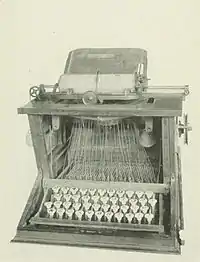QWERTY
English
WOTD – 17 February 2018
Etymology

American inventor Christopher Latham Sholes (1819–1890), who came up with the QWERTY keyboard.[1]

An 1873 Sholes typewriter featuring a QWERTY keyboard.[2]
From the first six letters on one of the upper rows of such a keyboard.
Pronunciation
- (Received Pronunciation) IPA(key): /ˈkwɜːti/, /ˈkwɛəti/
Audio (RP) (file) - (General American) IPA(key): /ˈkwɚti/, [-ɾi]
Audio (AU) (file) - Rhymes: -ɜː(ɹ)ti
- Hyphenation: qwer‧ty
Adjective
QWERTY (not comparable)
- (computing, typography) Denoting a standard layout of keys on a keyboard for typing, in which the leftmost keys of the top lettered row are Q-W-E-R-T-Y.
- Synonym: QWERTYUIOP
- Coordinate terms: azerty, Dvorak, qwertz
- 1978, Allen Kent, Harold Lancour, Jay E[lwood] Daily, editors, Encyclopedia of Library and Information Science, volumes 24 (Printers and Printing to Public Policy, Copyright), New York, N.Y., Basel: Marcel Dekker, →ISBN, page 109:
- It was the Monotype model D keyboard introduced in 1907 which became the standard for printers, with a "qwerty" typewriter lay and removable keybars which made the keyboard independent of the matrix case arrangement.
- 1991, Marilyn Cochran-Smith, Cynthia L. Paris, Jessica L. Kahn, “Hunting, Pecking, and Checking: Learning to Write with Word Processing”, in Learning to Write Differently: Beginning Writers and Word Processing (Language and Educational Processes), Norwood, N.J.: Ablex Publishing, →ISBN, page 137:
- The older children we came to know had had a great deal of experience with written language, and they certainly had a firm grasp of the alphabetic sequence. They were annoyed with the arrangement of letters on the typewriter keyboard, which begins at the second from the top row and proceeds left to right with the letters, "Q," "W," "E," "R," "T," and "Y." Computer professionals, who refer to this arrangement as the "QWERTY keyboard," have pointed out that, although it originated in order to avoid jam-ups of frequently used keys on the manual typewriter, the QWERTY arrangement is now completely obsolete but apparently here to stay. Third and fourth graders knew only that QWERTY had no logic that they could discern, and, until they developed basic keyboard familiarity, it greatly delayed their attempts at finding the keys they needed.
- 1992, Jack Hirshleifer, John G. Riley, “Strategic Uncertainty and Equilibrium Concepts”, in The Analytics of Uncertainty and Information (Cambridge Surveys of Economic Literature), Cambridge: Cambridge University Press, published 2002, →ISBN, section 9.1 (Nash Equilibrium), page 330:
- […] The Dvorak typewriter keyboard is, it has been claimed, ergonomically superior to the standard "Qwerty" arrangement. But having settled on the current standard keyboard, largely by historical accident, now manufacturers are supposedly reluctant to produce Dvorak keybboards so long as almost all typists are trained on Qwerty, while typists don't want to train on Dvorak when almost all keyboards are Qwerty. Even the inferior keyboard as a matched choice is superior to failing to coordinate at all.
- 1993 September 11, John Ballard, “RSI on Trial: More People Suffering from Repetitive Strain Injury are Seeking Compensation in Court as Fresh Evidence Comes to Light about the Symptoms and Causes of this Crippling Disorder”, in New Scientist, London: New Scientist Ltd., →ISSN, →OCLC, archived from the original on 13 April 2016:
- The ‘QWERTY’ layout of keyboards is also a cause for concern. The design means that the fingers of the left hand (the less dominant hand for most Westerners) do 57 per cent of the work in typing English text. RSI symptoms are often found to be more intense in the left hand of keyboard users.
- 1994, Henri-Jean Martin, “Beyond Writing”, in Lydia G. Cochrane, transl., The History and Power of Writing, Chicago, Ill., London: University of Chicago Press, →ISBN, page 465:
- The typewriter using separate characters on type bars striking on a cylinder soon dominated the market. Because adjacent striking bars tended to jam when struck rapidly, manufacturers abandoned the alphabetical placement of letters on the keyboard in favor of the left-to-right "qwerty" disposition that takes into account the frequency and sequence of letters in English.
Derived terms
Translations
denoting a standard layout of keys on a keyboard for typing
References
- Frontispiece of Charles E[dward] Weller (1918) The Early History of the Typewriter, La Porte, Ind.: Chase & Shepard, printers, →OCLC
- From George Iles (1912) Leading American Inventors. With Fifteen Portraits and Many Illustrations, New York, N.Y.: Henry Holt and Company, →OCLC
This article is issued from Wiktionary. The text is licensed under Creative Commons - Attribution - Sharealike. Additional terms may apply for the media files.